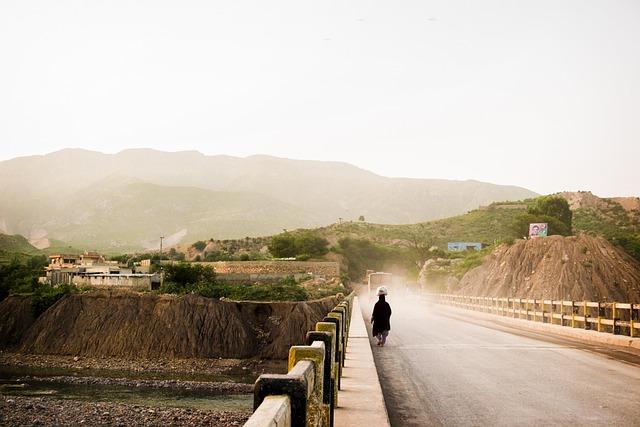As the sun rises over the sprawling urban landscapes and picturesque villages of Pakistan, a subtle yet powerful transformation is underway. The nation stands at a crossroads, where the echoes of its rich historical tapestry meet the urgent calls for modernity. In a world where infrastructure serves as the backbone of economic vitality and social cohesion, Pakistan is poised to embark on a journey of revitalization. “Revamping Pakistan’s Infrastructure: A Path to Growth and Resilience” explores the imperative need for comprehensive improvements in roads, bridges, ports, and utilities that not only cater to the demands of a burgeoning population but also fortify the resilience of communities against the challenges of environmental change and economic volatility. This article delves into the potential of innovative infrastructure development as a catalyst for sustainable growth, examining the intricate interplay between investments, technological advancements, and strategic planning. Join us as we navigate this landscape of opportunity, envisioning a future where robust infrastructure paves the way for a dynamic and thriving Pakistan.
Embracing Sustainable Development: Modernizing Urban Infrastructure for Future Generations
The future of urban living hinges on the efficient integration of sustainable development into our cities. Modernizing infrastructure not only enhances the quality of life for residents but also plays a pivotal role in mitigating the effects of climate change. In Pakistan, where rapid urbanization poses significant challenges, it is essential to adopt innovative solutions that prioritize environmental stewardship. This can be achieved by implementing green building practices, optimizing public transportation, and promoting the use of renewable energy sources. Such initiatives can lead to a holistic transformation of urban spaces, making them more resilient to the pressures of growing populations.
To realize this vision, collaboration between government agencies, private sector stakeholders, and local communities is vital. Effective strategies should include:
- Investment in Smart Technologies: Utilizing IoT and smart grid systems to enhance energy efficiency.
- Community Engagement: Involving residents in decision-making processes to ensure that developments meet their needs.
- Green Spaces: Creating parks and recreational areas to promote social well-being and reduce urban heat.
- Waste Management Initiatives: Implementing recycling programs and waste-to-energy technologies to minimize landfill use.
Incorporating these strategies can boost economic growth while building resilience against environmental challenges. A comprehensive approach should also include assessing current infrastructure and identifying areas for improvement. The table below highlights key infrastructure components that require urgent attention:
| Infrastructure Component | Current Status | Proposed Improvement |
|---|---|---|
| Public Transport | Inadequate coverage | Expand metro and bus networks |
| Waste Management | Low recycling rates | Enhance recycling facilities |
| Water Supply | Frequent shortages | Upgrade pipeline systems |
| Energy Supply | Heavy reliance on fossil fuels | Increase renewable energy investments |

Fostering Connectivity: Enhancing Transportation Networks to Drive Economic Prosperity
Strengthening transportation networks is fundamental to unlocking economic potential and enhancing the quality of life across communities. A well-integrated and efficient transportation system can act as a catalyst for growth, providing businesses with greater access to markets and facilitating the movement of goods and services. Key strategies to enhance connectivity include:
- Investment in Public Transit: Developing robust bus and rail systems to reduce congestion and provide affordable travel options.
- Upgrading Road Infrastructure: Ensuring that highways and local roads can accommodate modern traffic demands.
- Implementing Smart Technology: Utilizing tech solutions for traffic management to optimize flow and reduce delays.
In addition to these strategies, fostering public-private partnerships can lead to innovative funding solutions and shared resources. Initiatives for building multi-modal transport hubs will also encourage seamless commuting options between different transport systems. To illustrate this growth potential, the following table outlines projected economic benefits from improved transportation:
| Benefit | Projected Increase |
|---|---|
| Job Creation | 15% over 5 years |
| Business Growth | 20% in key sectors |
| Increased Accessibility | 50% more regions served |

Investing in Water and Energy: Building Resilient Systems for Equitable Access
As Pakistan grapples with the pressing challenges of resource scarcity and infrastructural deficiencies, strategic investments in water and energy sectors stand as pillars for national resilience. Building more robust and equitable systems begins by prioritizing sustainable technologies that enhance efficiency and accessibility. Initiatives focusing on:
- Renewable Energy Sources: Expanding solar, wind, and hydropower capabilities to diversify energy portfolios.
- Water Conservation Techniques: Implementing techniques like rainwater harvesting and advanced irrigation methods to optimize usage.
- Decentralized Energy Grids: Encouraging local energy generation to empower communities and reduce transmission losses.
Moreover, collaborative efforts among government entities, private sectors, and local communities are crucial. Constructing frameworks that facilitate equitable access to essential resources involves:
- Public-Private Partnerships (PPPs): Leveraging private investment for infrastructure development.
- Community Engagement: Involving local populations in decision-making processes to ensure that their needs are adequately addressed.
- Training and Capacity Building: Educating individuals about sustainable practices and maintenance of systems to promote longevity and efficacy.
| Investment Area | Key Benefits |
|---|---|
| Solar Energy | Reduced electricity costs and increased grid reliability. |
| Water Recycling | Less strain on freshwater resources and improved sanitation. |
| Wind Farms | Job creation in rural areas and reduced greenhouse gas emissions. |

Leveraging Technology: Smart Solutions for Efficient Infrastructure Management
As Pakistan strives to modernize its infrastructure, integrating smart technology solutions emerges as a vital strategy for enhancing operational efficiency. By deploying advanced systems such as IoT sensors, AI-driven analytics, and cloud-based management platforms, infrastructure managers can gain real-time insights into the health and usage patterns of assets. These tools facilitate proactive maintenance, enabling timely interventions that can significantly reduce costs and downtime. Furthermore, through data analysis, decision-makers can optimize resource allocation, streamline workflows, and enhance overall service delivery.
To illustrate the potential impact of these technologies, consider the following table showcasing examples of smart solutions and their benefits for infrastructure management:
| Smart Solution | Benefits |
|---|---|
| IoT Sensors | Real-time monitoring of infrastructure conditions |
| AI Predictive Maintenance | Reduced downtime through early fault detection |
| Cloud-based Management | Centralized data access for improved collaboration |
| Automated Reporting Tools | Efficient tracking of performance metrics |
These innovative tools are not just about improving existing practices; they also open up pathways for transforming urban planning and community development. By utilizing data to inform policy and project decisions, Pakistan can create sustainable and resilient infrastructures that bolster economic growth while adapting to the challenges posed by climate change and rapid urbanization. The convergence of technology and infrastructure management is not merely a trend; it is the foundation upon which the future of Pakistan’s development will be built.
The Conclusion
As we stand at the crossroads of development and opportunity, revamping Pakistan’s infrastructure emerges not just as a necessity, but as a blueprint for a resilient future. The cast of crumbling roads and congested cities must give way to a vision where sustainable growth and connectivity thrive. By embracing innovative techniques, fostering public-private partnerships, and prioritizing green technologies, Pakistan can transcend its current challenges and emerge stronger than ever.
The journey towards a revamped infrastructure is long, but essential investments today can pave the way for an empowered tomorrow. It calls for collaboration across sectors, engagement from communities, and a commitment to forward-thinking policies that reflect the aspirations of a nation poised for greatness.
In this transformative endeavor, let us remember that infrastructure is more than concrete and steel; it is the lifeblood of economic vitality and the foundation of societal progress. As we lay the groundwork for this new era, let each initiative resonate with our shared vision of a prosperous Pakistan—one that harnesses its potential, nurtures its resilience, and flourishes for generations to come.



